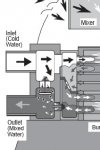This goes against most of the analysis in the forums - specifically the assertion that we do not need an external bypass since an internal bypass exists in the heater- And placing one will let water sit in the coils for an extended period of time.
I would like to disagree based primarily on the diagram below- please correct me if my analysis is wrong.
The internal bypass and the thermal regulator valves are what I focused on.
1- when the heater is off- the thermal regulator valve is closed off. All the water flow is forced to go through the internal bypass. Any water that is in the coils remains there. If you don’t use your heater for months, that water will remain the coils for months.
So when the heater is off - the drop in psi is primarily across the internal bypass valve.
2- When the heater is functional the thermal regulator valve opens to varying degrees based on the temperature of the water coming from the coils. At very high flows if the temperature change is not significant the valve closes and more of the water is shunted through the bypass valve. Also at high flows- the bypass valve prevents too much flow through the coils. ( same thing as prior sentence but for a different reason- mechanical and flow balance versus appropriate heat transfer)
in essence, an external bypass it’s completely different than the internal bypass of the heater. When the heater is nonfunctional the external bypass gives the benefit of reduced TDH added by the internal bypass valve. with a VS pump I can further drop my RPM and get the same flows with significant energy savings.
No numbers- I would guess the internal bypass valve has a cross sectional area of a 1.5 PVC pipe? And the spring load- a 3-4 psi drop?
A first order analysis- please correct if there are other systems and bits I have overlooked.
I would like to disagree based primarily on the diagram below- please correct me if my analysis is wrong.
The internal bypass and the thermal regulator valves are what I focused on.
1- when the heater is off- the thermal regulator valve is closed off. All the water flow is forced to go through the internal bypass. Any water that is in the coils remains there. If you don’t use your heater for months, that water will remain the coils for months.
So when the heater is off - the drop in psi is primarily across the internal bypass valve.
2- When the heater is functional the thermal regulator valve opens to varying degrees based on the temperature of the water coming from the coils. At very high flows if the temperature change is not significant the valve closes and more of the water is shunted through the bypass valve. Also at high flows- the bypass valve prevents too much flow through the coils. ( same thing as prior sentence but for a different reason- mechanical and flow balance versus appropriate heat transfer)
in essence, an external bypass it’s completely different than the internal bypass of the heater. When the heater is nonfunctional the external bypass gives the benefit of reduced TDH added by the internal bypass valve. with a VS pump I can further drop my RPM and get the same flows with significant energy savings.
No numbers- I would guess the internal bypass valve has a cross sectional area of a 1.5 PVC pipe? And the spring load- a 3-4 psi drop?
A first order analysis- please correct if there are other systems and bits I have overlooked.


